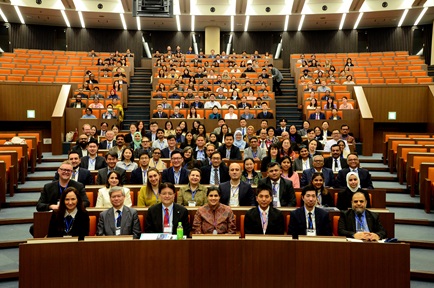Have you got the EMO for success?
Why do some entrepreneurs manage to overcome problems and setbacks to create improved products or start new ventures, while others decide it is better for them to throw in the towel?
By Foo Maw-Der

American inventor-entrepreneur Thomas Edison tried 1,000 times before he succeeded in designing a light bulb that worked. Henry Ford reportedly went broke five times before he became known as the founder of modern American industrial mass production methods.
In more recent times, China's Jack Ma pulled back his Alibaba - which he famously called "1,001 mistakes" - from the brink of bankruptcy, after having expanded too fast, to become one of the world's largest e-commerce companies.
Singapore, too, has its own slate of entrepreneurs who have had to grapple with their share of challenges, such as Eighteen Chefs' Benny Se Teo and Creative Technology's Sim Wong Hoo.
With the literature on entrepreneurship throughout the ages replete with stories of never-say-die startup founders and comeback kids, one question needs to be asked: Why do some entrepreneurs manage to overcome problems and setbacks to create improved products or start new ventures, while others decide it is better for them to throw in the towel?
The answer may well lie in whether they have a high or low "error mastery orientation (EMO)", which captures the extent to which people take a positive stance towards errors, perceive errors to be inevitable and consider errors as opportunities to learn. So while they do not believe that errors are desirable, their goal is to minimise the negative - and maximise the positive - consequences, especially in the area of learning.
In entrepreneurship, EMO can also be applied to problems since they share common features with errors in terms of being unwelcome, harmful and making it difficult for goals to be achieved. EMO in this case functions like a switch, turning problems into something good - or bad - in terms of entrepreneurial learning, depending on whether the person has high or low EMO.
No entrepreneur would want to be saddled with any problems, especially at the start of a venture, since this means investing time and money to deal with them - putting further strain on his/her already stretched resources. Problems can also have a psychological impact, such as decreasing the entrepreneur's self-esteem and bringing negative emotions like anger and anxiety to the fore.
Yet, for all the distress that they bring, problems can actually help the entrepreneur in his/her learning journey in three ways: increase one's attention to a particular area; provide information; and instigate exploration.
Focused attention
When one's attention is more focused, it could lead to new insights and a better understanding why a certain process, for example, is not producing the desired results. As a form of "negative feedback", problems can reveal incorrect assumptions and signal that something needs to be corrected. This can lead the entrepreneur to explore possible alternative actions to overcome or circumvent the problem which, in turn, can lead to new discoveries and insights about successful actions.
So, while Steve Jobs had his share of duds such as the Apple Lisa and Macintosh TV, that did not stop him from continuing to innovate and ultimately producing big hits like the iPhone and iPad.
Indeed, a recent study showed that problems had a positive indirect effect on venture progress through entrepreneurial learning in the case of those with high EMO, and a negative indirect effect in the case of low EMO.
The study involved nearly 170 students from two universities in Uganda and Kenya who participated in a 12-week entrepreneurship training course. The programme required the participants - who each received a starting capital of US$100 and were divided into 55 entrepreneurial teams - to launch a real micro-business, with the aim of creating a business that generated profit within the duration of the course. The businesses included selling flash drives, producing sweets or offering manicure services.
At the end of the course, the participants, on average, made a profit of US$40, and 84 per cent of them were able to return the US$100 capital.
During the study, the students were regularly asked to answer questions, such as the number of problems and the most severe setback that they encountered in the past week. The problems were listed under six categories, such as financial (customers not paying on time) or marketing (no interest in the product) or production (transportation of goods to the marketplace).
They were also asked to indicate the severity of the described problem, based on a scale ranging from "not at all" to "absolutely".
The students were observed on their "entrepreneurial learning" as well - such as whether they had been able to detect signs that their business was in trouble; or whether they had learnt to better execute a business strategy; and whether they had learnt to run their business more effectively. Again, their answers were on a scale ranging from "not at all" to "absolutely".
Based on 1,016 observations from the 168 participants, the study found, among other things, that the relationship between problems and entrepreneurial learning was positive for those with high EMO, and negative for those with low EMO.
Thus, those participants who were high in EMO benefited from the problems that cropped up during the course, since these were viewed as an opportunity for more frequent learning in the day-to-day operations.
On the other hand, participants with a low EMO reacted negatively to problems which, in turn, affected both their learning and progress of their venture.
Learning from problems on the entrepreneurial journey thus helps a business venture to progress because the entrepreneur uses improved knowledge and more effective actions for his/her next steps, the study concluded.
Given the importance of having a high EMO, how can an entrepreneur develop a mindset that embraces a positive approach towards problems?
The answer lies in framing errors in a positive light such as "the more errors you make, the more you learn". Such an approach has been found to positively affect entrepreneurs' attitude towards errors - and thus problems - and increase their ability to learn from errors.
Learning from errors
One can also participate in a training programme that directly influences a person's attitude in viewing and managing errors. Such a programme covers areas such as learning from errors, error risk-taking, and error anticipation.
It has sometimes been said that for entrepreneurs to achieve success, they have to "fail fast, fail often". Perhaps, it is time for entrepreneurs to embrace another mantra - "learn fast, learn often" - from problems that inevitably arise whenever they embark on a venture.
The writer is an associate professor at Nanyang Business School, Nanyang Technological University Singapore. The research mentioned in this article is co-authored with Rebecca Funken and Michael M Gielnik, both from Leuphana University of Luneburg in Germany.







